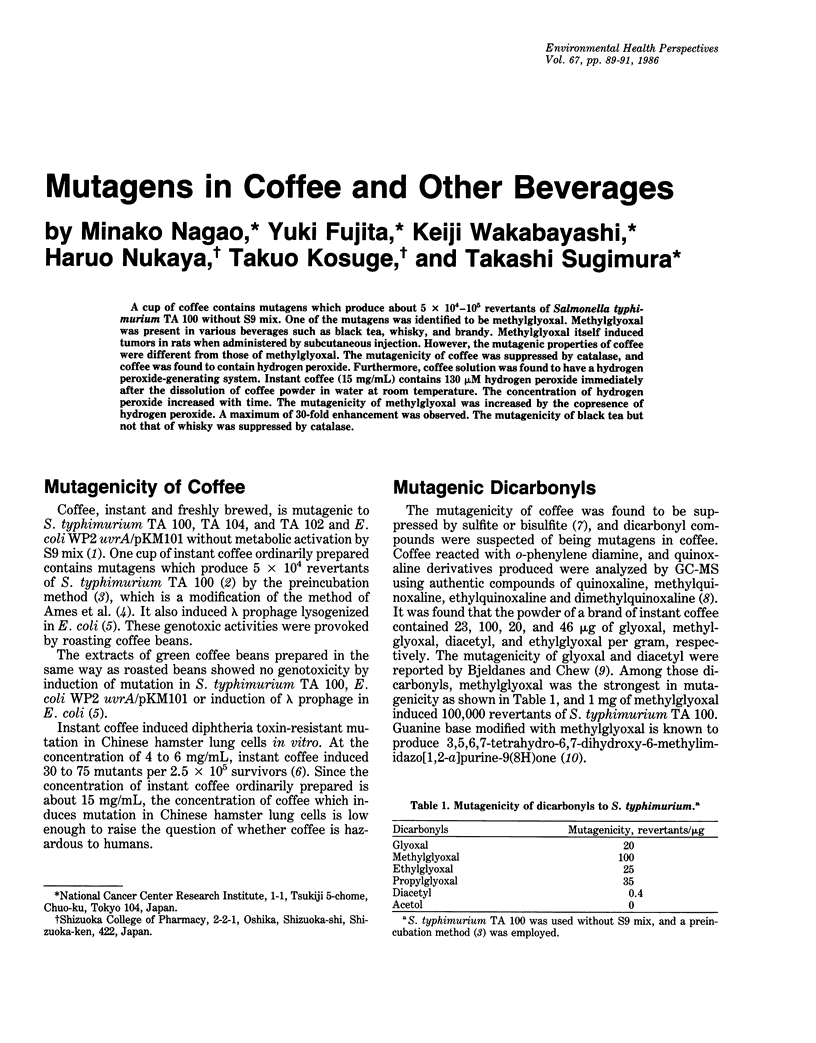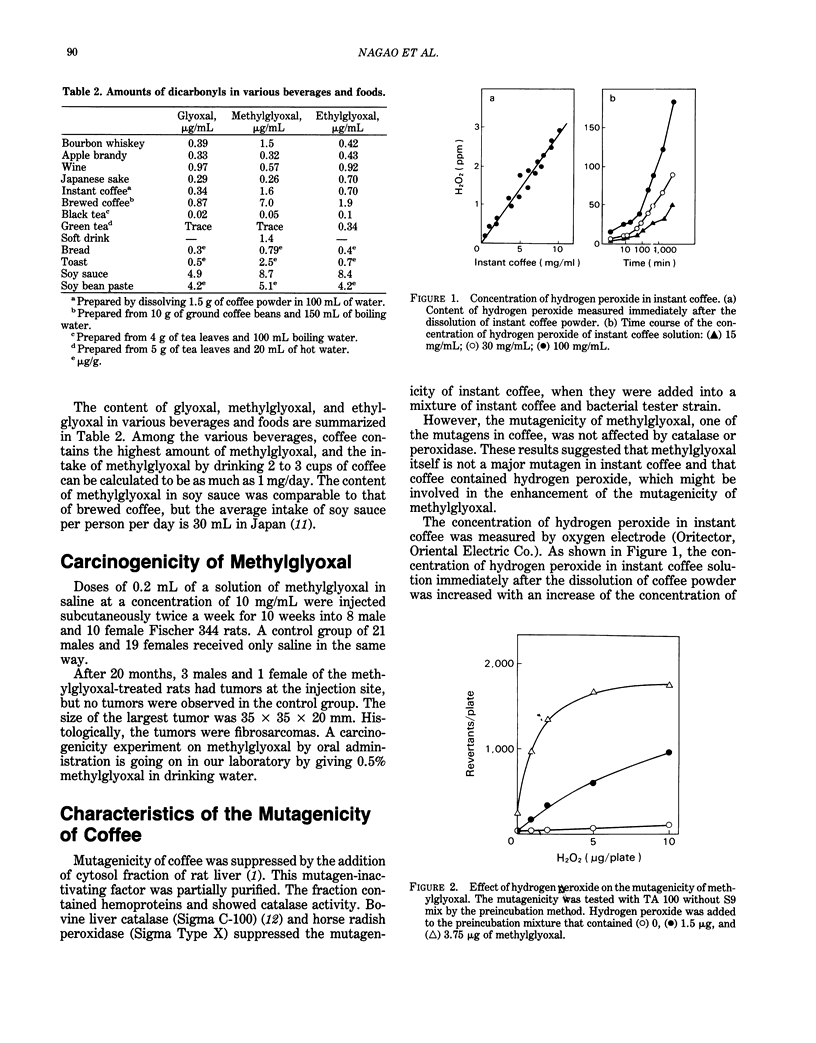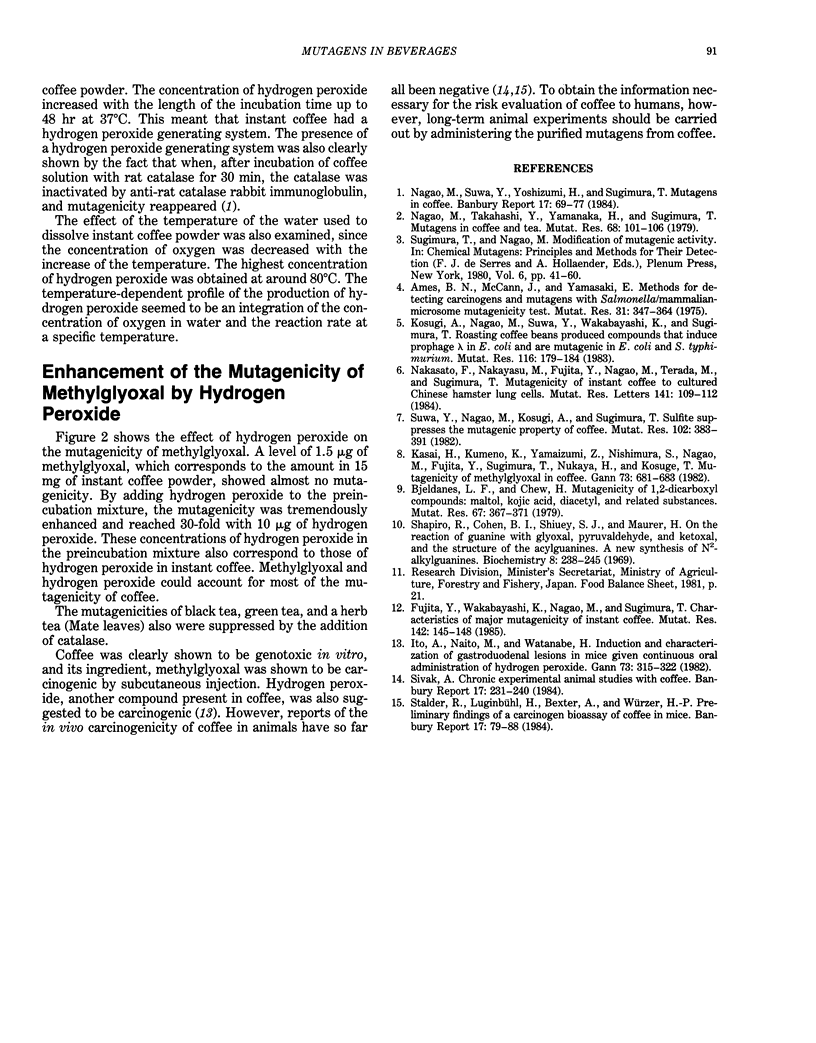Abstract
A cup of coffee contains mutagens which produce about 5 X 10(4)-10(5) revertants of Salmonella typhimurium TA 100 without S9 mix. One of the mutagens was identified to be methylglyoxal. Methylglyoxal was present in various beverages such as black tea, whisky, and brandy. Methylglyoxal itself induced tumors in rats when administered by subcutaneous injection. However, the mutagenic properties of coffee were different from those of methylglyoxal. The mutagenicity of coffee was suppressed by catalase, and coffee was found to contain hydrogen peroxide. Furthermore, coffee solution was found to have a hydrogen peroxide-generating system. Instant coffee (15 mg/mL) contains 130 microM hydrogen peroxide immediately after the dissolution of coffee powder in water at room temperature. The concentration of hydrogen peroxide increased with time. The mutagenicity of methylglyoxal was increased by the copresence of hydrogen peroxide. A maximum of 30-fold enhancement was observed. The mutagenicity of black tea but not that of whisky was suppressed by catalase.
Full text
PDF


Selected References
These references are in PubMed. This may not be the complete list of references from this article.
- Ames B. N., Mccann J., Yamasaki E. Methods for detecting carcinogens and mutagens with the Salmonella/mammalian-microsome mutagenicity test. Mutat Res. 1975 Dec;31(6):347–364. doi: 10.1016/0165-1161(75)90046-1. [DOI] [PubMed] [Google Scholar]
- Bjeldanes L. F., Chew H. Mutagenicity of 1,2-dicarbonyl compounds: maltol, kojic acid, diacetyl and related substances. Mutat Res. 1979 Aug;67(4):367–371. doi: 10.1016/0165-1218(79)90034-x. [DOI] [PubMed] [Google Scholar]
- Fujita Y., Wakabayashi K., Nagao M., Sugimura T. Characteristics of major mutagenicity of instant coffee. Mutat Res. 1985 Apr;142(4):145–148. doi: 10.1016/0165-7992(85)90013-2. [DOI] [PubMed] [Google Scholar]
- Ito A., Naito M., Naito Y., Watanabe H. Induction and characterization of gastro-duodenal lesions in mice given continuous oral administration of hydrogen peroxide. Gan. 1982 Apr;73(2):315–322. [PubMed] [Google Scholar]
- Kasai H., Kumeno K., Yamaizumi Z., Nishimura S., Nagao M., Fujita Y., Sugimura T., Nukaya H., Kosuge T. Mutagenicity of methylglyoxal in coffee. Gan. 1982 Oct;73(5):681–683. [PubMed] [Google Scholar]
- Kosugi A., Nagao M., Suwa Y., Wakabayashi K., Sugimura T. Roasting coffee beans produces compounds that induce prophage lambda in E. coli and are mutagenic in E. coli and S. typhimurium. Mutat Res. 1983 Mar;116(3-4):179–184. doi: 10.1016/0165-1218(83)90058-7. [DOI] [PubMed] [Google Scholar]
- Nagao M., Takahashi Y., Yamanaka H., Sugimura T. Mutagens in coffee and tea. Mutat Res. 1979 Oct;68(2):101–106. doi: 10.1016/0165-1218(79)90137-x. [DOI] [PubMed] [Google Scholar]
- Nakasato F., Nakayasu M., Fujita Y., Nagao M., Terada M., Sugimura T. Mutagenicity of instant coffee on cultured Chinese hamster lung cells. Mutat Res. 1984 Oct;141(2):109–112. doi: 10.1016/0165-7992(84)90020-4. [DOI] [PubMed] [Google Scholar]
- Shapiro R., Cohen B. I., Shiuey S. J., Maurer H. On the reaction of guanine with glyoxal, pyruvaldehyde, and kethoxal, and the structure of the acylguanines. A new synthesis of N2-alkylguanines. Biochemistry. 1969 Jan;8(1):238–245. doi: 10.1021/bi00829a034. [DOI] [PubMed] [Google Scholar]
- Suwa Y., Nagao M., Kosugi A., Sugimura T. Sulfite suppresses the mutagenic property of coffee. Mutat Res. 1982 Dec;102(4):383–391. doi: 10.1016/0165-1218(82)90101-x. [DOI] [PubMed] [Google Scholar]


